Key takeaways:
- Recognizing and adapting to diverse learning needs is essential for fostering an inclusive educational environment, as demonstrated through various student experiences.
- Implementing adaptable assessments, such as creative projects and flexible formats, can unlock students’ true potential and enhance their engagement.
- Effective tools and strategies, including technology, tailored rubrics, and scaffolding techniques, are crucial for assessing and supporting diverse learners.
- Personal experiences highlight the positive impact of adaptations on student confidence and participation, underscoring the importance of flexibility in assessment methods.
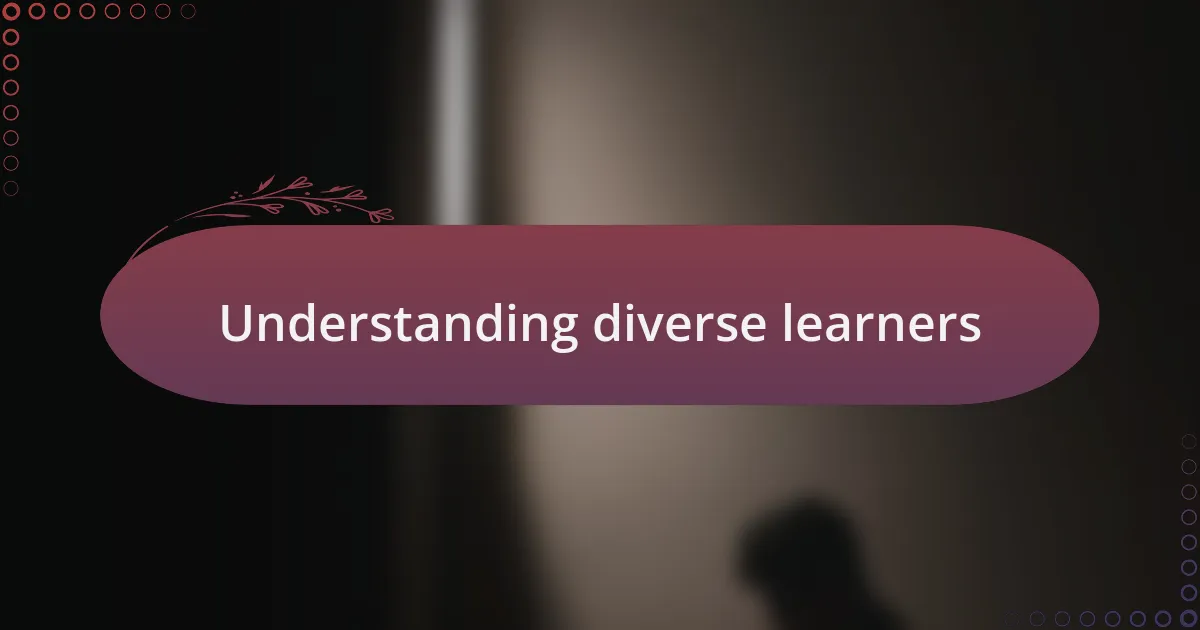
Understanding diverse learners
Understanding diverse learners requires a deep commitment to recognizing their unique needs and strengths. I remember a time in my classroom when a student with a hearing impairment felt isolated during group discussions. It struck me that simply making adjustments, like using visual aids and providing note outlines, transformed their experience and fostered their engagement.
Every learner has a story, often shaped by cultural backgrounds, abilities, and personal experiences. I often find myself wondering, how can we leverage these stories to create a more inclusive environment? One memorable experience was when a student from a non-English speaking background shared their traditional practices during a project. This not only enriched our classroom but also made other students curious and appreciative of diverse perspectives.
Recognizing the variations in learning styles is crucial. For instance, I once had a kinesthetic learner who thrived through hands-on activities. It’s fascinating how allowing them to move around and manipulate materials resulted in astonishing academic growth. Have you ever witnessed a student shine simply because the learning environment was tailored to fit their style? Each moment like this reinforces my belief that understanding diverse learners is not just beneficial—it’s essential for fostering an inclusive education.
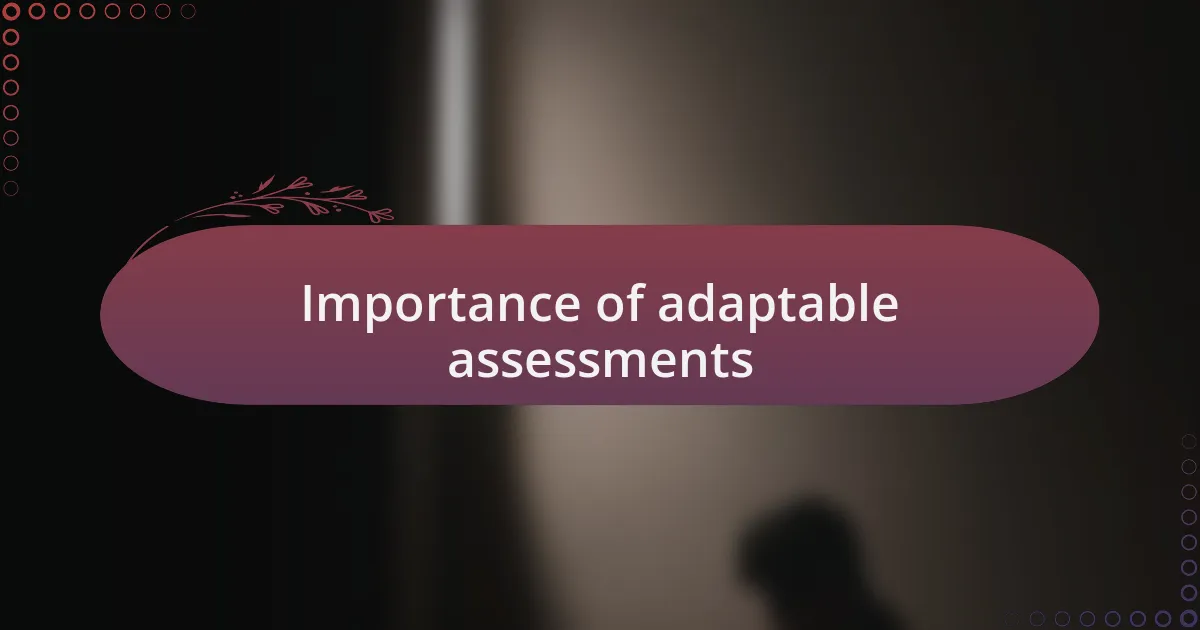
Importance of adaptable assessments
Adaptable assessments are vital because they allow educators to meet learners at their own level. I recall an instance when a student with dyslexia struggled with traditional testing formats, which led to stress and poor performance. By offering them the option to demonstrate understanding through a creative project instead, I witnessed a complete transformation; they not only showcased their knowledge but also regained their confidence. Isn’t it remarkable how a small change in assessment can unlock a learner’s true potential?
The flexibility of adaptable assessments also empowers students to express their learning in ways that resonate with them personally. I once had a student who was an avid painter; instead of the standard written report, I encouraged them to illustrate their interpretations of a historical event. The pride they felt in sharing their visual representation not only enhanced their learning experience but also inspired their classmates to think outside the box. How often do we overlook unique talents that could shine during assessments?
Moreover, adaptable assessments play a crucial role in creating a fair evaluation system. I’ve seen firsthand how students with varying needs can thrive when provided with tailored approaches. For instance, one of my students had anxiety around timed quizzes, causing them to freeze under pressure. By implementing untimed assessments, they were finally able to demonstrate their knowledge without the added stress. When we consider the ethos of education, shouldn’t we strive to ensure that every student has a fair opportunity to succeed?
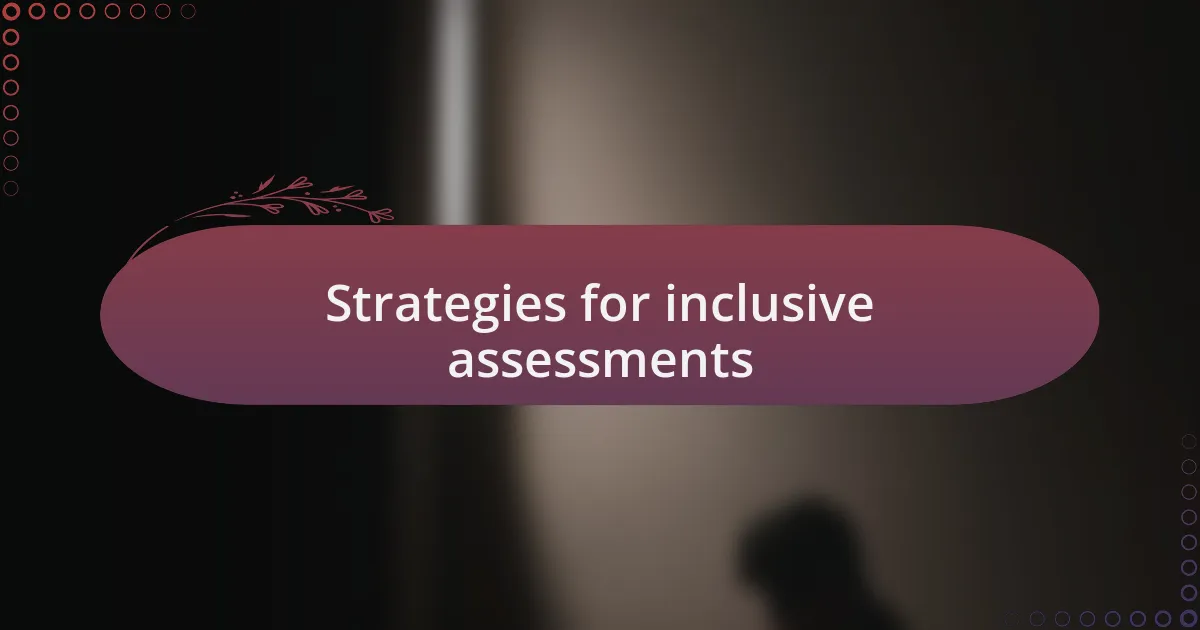
Strategies for inclusive assessments
To create inclusive assessments, I often incorporate varied formats that cater to different learning styles and needs. For example, in one of my classes, I introduced vocabulary assessments through oral presentations for some students while allowing others to complete traditional written tests. It was heartwarming to see students who typically struggled with written expression shine when they could articulate their thoughts verbally. Isn’t it fascinating how embracing multiple formats can illuminate the strengths of diverse learners?
Another effective strategy I’ve found is offering choices within assessments. I remember designing a project-based assessment where students could choose between a written report, a presentation, or a video project. This not only fostered engagement but also allowed students to select a medium that suited their comfort levels. It’s amazing how giving students a voice in their assessment methods can lead to deeper learning outcomes. Have you noticed how students often perform better when they feel they have control over their learning?
Lastly, I utilize scaffolding techniques to support all learners. For instance, in a math unit, I provided step-by-step guidelines and checklists that helped students navigate complex problems. With these strategies in place, many students felt more empowered and confident to tackle challenging content. How often do we underestimate the value of providing structured support during assessments? It’s rewarding to see the impact of such approaches, as they pave the way for equitable learning experiences for every student.
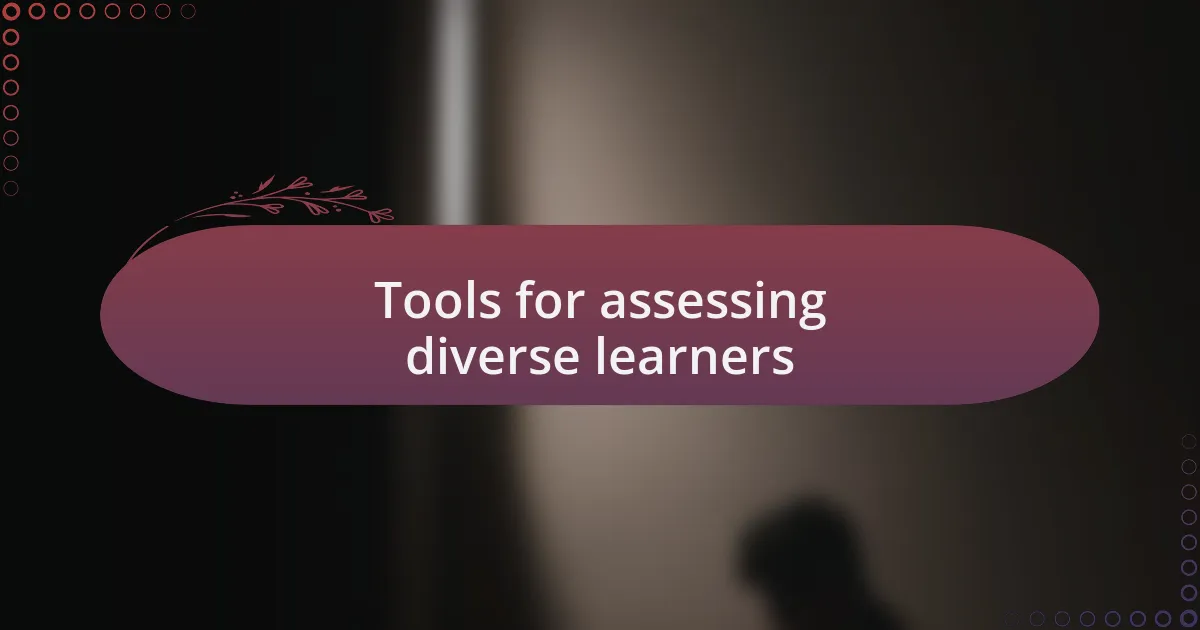
Tools for assessing diverse learners
When assessing diverse learners, I’ve found that digital tools can be game-changers. For instance, using platforms like Google Forms allows me to create quizzes with various question types, from multiple-choice to interactive multimedia. I remember a time when a student who struggled with conventional tests thrived when I included audio prompts—they could listen to the questions instead of reading them. How motivating it is to see technology bridging gaps in understanding!
Another tool that I’ve found particularly useful is rubrics tailored for diverse learners. By breaking down criteria into clear, understandable segments, I can provide specific feedback that resonates with each student’s unique strengths. I once designed a rubric for a collaborative project and included “teamwork” as a category, which encouraged students to reflect not only on their individual contributions but also on how they supported one another. Isn’t it incredible how focused feedback can help students recognize their value in a group setting?
Lastly, I can’t stress enough the benefit of using formative assessments like observations and journals. These allow me to gauge student progress over time and adjust instruction as needed. I recall using learning journals where students reflected on their understanding weekly, leading to enlightening discussions about their learning styles. Doesn’t it feel rewarding to witness such personal growth in our students? It’s these tools that make assessing diverse learners not just a task, but a valuable journey toward understanding.
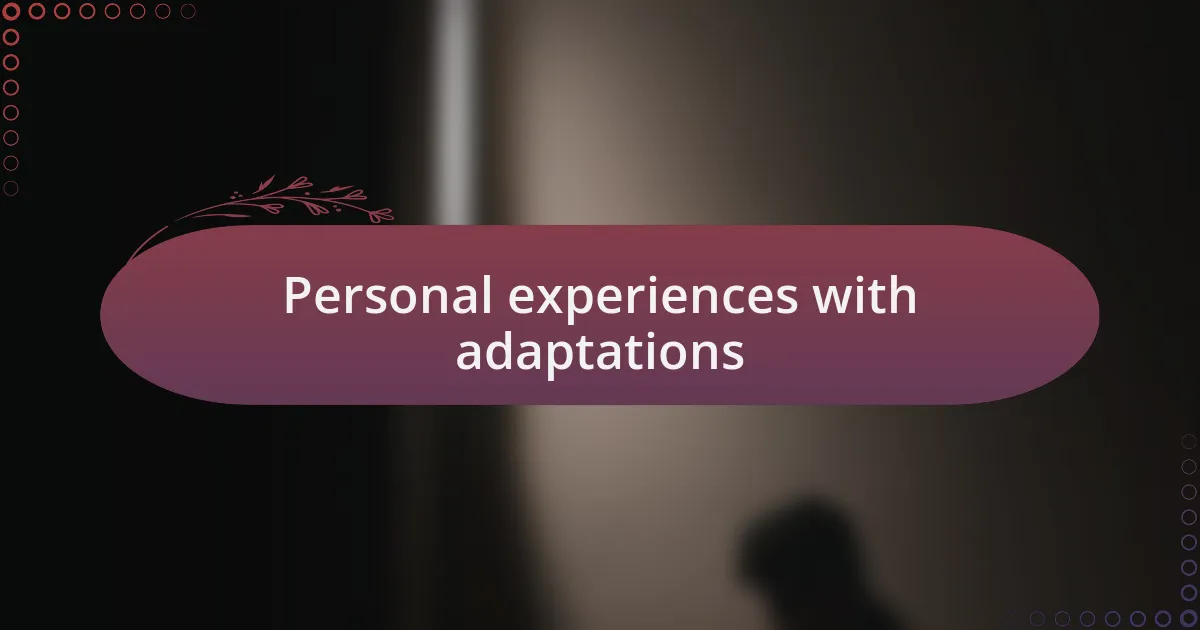
Personal experiences with adaptations
When I began adapting assessments for diverse learners, I was initially overwhelmed by the variety of needs in my classroom. I remember standing in front of my students, feeling the pressure of ensuring each one felt included. One day, I decided to provide options in how they could demonstrate understanding—some chose to write essays while others created videos. The smiles on their faces when they engaged in a way that resonated with them were truly heartwarming.
There was a moment during a science project that profoundly impacted my perspective on adaptations. A student with dyslexia struggled with written reports but excelled in hands-on activities. I encouraged her to present her findings through a PowerPoint presentation instead. As she animatedly explained her work to the class, I could see the confidence blooming within her. Isn’t it fascinating how a simple adjustment can unlock a world of potential in a student?
Sometimes, I reflect on how these adaptations have changed my teaching philosophy. I vividly recall a student who was shy and hesitant to participate in discussions. By allowing him to submit his insights through audio recordings, he began to share thoughts he had previously kept to himself. Witnessing his transformation made me question traditional assessment methods—could it be that by offering flexibility, we not only assess knowledge but also nurture the confidence that fuels a love for learning?
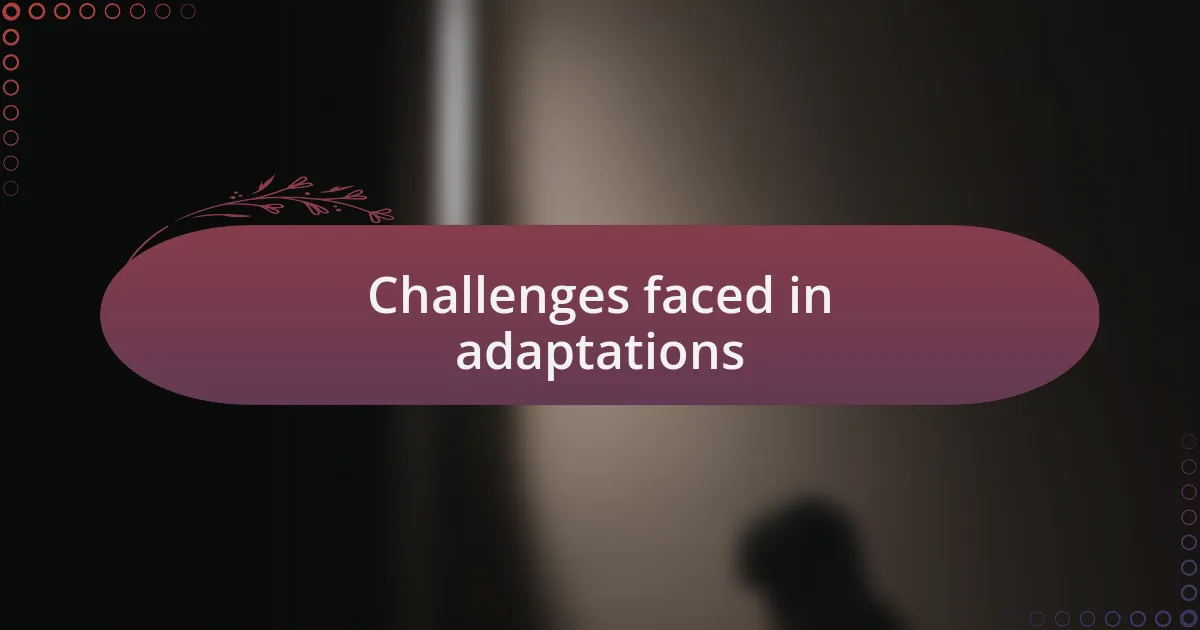
Challenges faced in adaptations
Witnessing the challenges of adapting assessments for diverse learners has been a real eye-opener. One particular instance stands out: I had structured a group project that seemed straightforward, but I quickly realized that not all my students could engage equally. Some struggled with collaboration due to social anxieties, while others felt overshadowed in larger groups. How could I ensure every voice was heard while still meeting educational goals?
Another challenge emerged when I attempted to integrate technology into my assessments. I remember a day when I planned to use an educational app to gauge student understanding. However, I found that not all students had access to devices, leaving some unable to participate fully. It made me ponder: how effective are our adaptations if they inadvertently highlight gaps in equity? In moments like this, I learned that flexibility isn’t just about altering tasks, but also about ensuring resources are genuinely accessible to each learner.
I also encountered setbacks while trying to balance rigor with relatability. There was a time I designed a creative assessment that allowed for artistic expression, thinking it would engage my students. However, a few felt overwhelmed by the open-ended nature, lacking the structure they craved. I couldn’t help but wonder—how can I offer creativity without straying too far from the familiar paths that guide my students? This balancing act between freedom and structure continues to challenge my approach to assessments, pushing me towards more inclusive yet academically sound strategies.
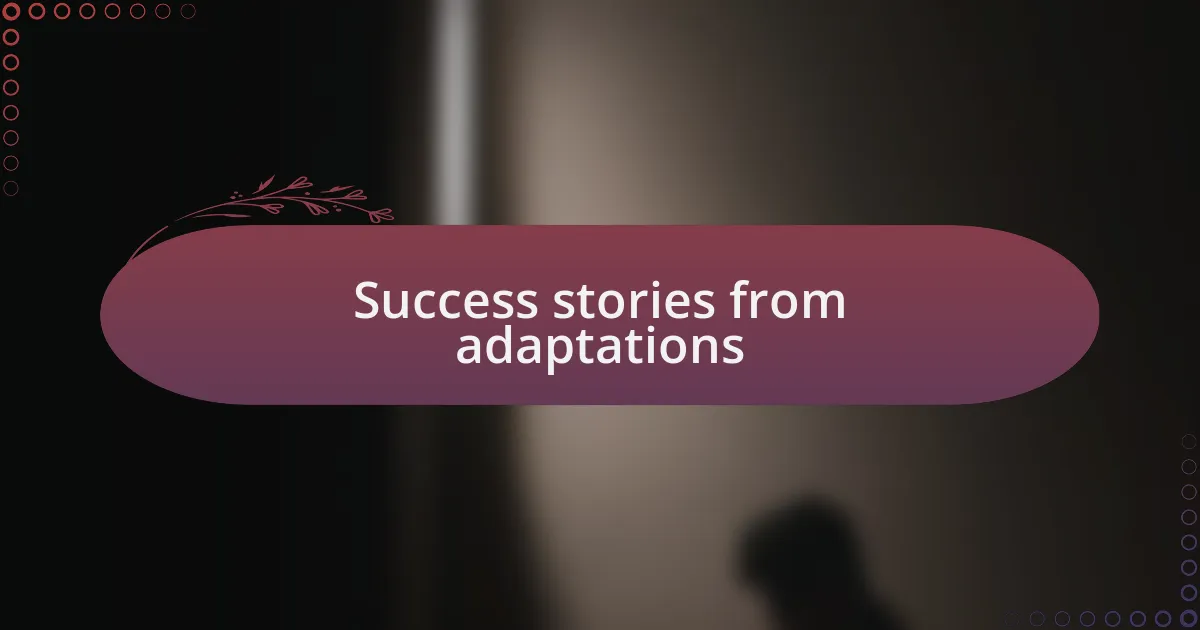
Success stories from adaptations
When I implemented adaptations in assessments, I noticed significant improvements in student engagement. One student, who traditionally struggled to express himself in writing, thrived when I allowed him to present his ideas through a video project. Watching him beam with pride as he shared his work with his classmates was a stark reminder of how the right adaptation can unleash potential.
In another instance, I restructured a math assessment to include visual aids and hands-on activities. I recall one student, who typically felt defeated by numbers, lighting up as she used manipulatives to solve problems. It was a powerful moment that made me question: how many more of my students could flourish if we simply changed the way we assess their understanding?
Additionally, I once introduced a choice board for a science project, offering students various ways to showcase their learning—be it through presentations, posters, or experiments. The excitement in the classroom was palpable as students discussed their choices and collaborated with each other. It sparked a new level of curiosity and camaraderie, prompting me to reflect on how true success in adaptations lies in allowing students to steer their own learning journeys.